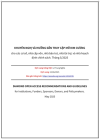Posted 13 Sep 2012 byNatalya Berenshteyn
Theo:http://opensource.com/law/12/9/creative-commons-applied
Bài được đưa lênInternet ngày: 13/09/2012
Lờingười dịch: Bài viết giới thiệu các cách thức làmquen với các giấy phép Creative Commons cho khu vực chínhphủ, giới doanh nghiệp và giới báo chí, đặc biệttrong một môi trường Internet phát triển như hiện nay.
Đối với nhữngngười muốn học về Creative Commons và ứng dụng của nótrong các khu vực khác nhau, có một biển các tư liệu cósẵn trên trực tuyến. Đặc biệt, các chi nhánh quốc tếcủa Creative Commons tạo ra một số lượng khổng lồ cáctài nguyên giáo dục xuyên khắp các ngôn ngữ và biêngiới văn hóa.
Ít tuần trước, tôiđã viết một bài về công việc của tôi đang phân loạiqua một số tài nguyên đó để xác định một số tốtnhất, tập trung vào sử dụng giấy phép Creative Commonscho thông tin khu vực nhà nước, cho việc xuất bản nộidung trong một loạt các nền tảng số, và cho việc tạora doanh thu. Như đã hứa, hôm nay tôi sẽ nhấn mạnh mộtsố các tài nguyên mà tôi đã phát hiện.
Giớithiệu về Creative Commons
Đối với những aichỉ mới làm quen với Creative Commons:
Video Creative Commons Qatar gặp Creative Commons đưa ra một giới thiệu tuyệt vời cho những lợi ích của việc cấp phép Creative Commons, các dạng giấy phép khác nhau trong bộ giấy phép Creative Commons, và cách chọn một giấy phép đúng cho tác phẩm của bạn.
Creative Commons Balan đã tạo ra một chỉ dẫn nhanh tuyệt vời cho các giấy phép trong quảng cáo mở của họ.
Nếu bạn đang tìm kiếm sâu hơn, thì sáng kiến Trường học Mở, một sự hợp tác giữa P2PU và Creative Commons, chỉ vừa được mở ra, nhưng nó đã đưa ra được ngay khóa học hiểu biết về Creative Commons.
Forpeople wanting to learn about Creative Commons and its application indifferent sectors, there is a sea of materials available online. Inparticular, CreativeCommons international affiliates cre-ate a huge number ofeducational resources that cross language and cultural boundaries.
Afew weeks ago, Iwrote a post about my work sorting through some of theseresources to identify some of the best, focusing on Creative Commonslicense use for public sector information, for publishing content ona variety of digital platforms, and for generating revenue. Aspromised, today I’ll highlight some of the resources I’vediscovered.
Introductionto Creative Commons
Forthose who are just getting acquainted with Creative Commons:
Creative Commons Qatar’s Meet Creative Commons video offers a great introduction to the benefits of Creative Commons licensing, the different types of licenses in Creative Commons’s license suite, and how to choose a license that’s right for your work.
Creative Commons Poland has cre-ated a great quick guide to the licences in their open poster.
If you’re looking for more depth, the new School of Open initiative, a collaboration between P2PU and Creative Commons, is just getting off the ground, but it already offers the short Get Creative Commons Savvy course.
Creative Commons vàchính phủ
Đối với những aicó quan tâm trong tiềm năng của các giấy phép CreativeCommons để khuyến khích sử dụng lại một cách khôngngờ và sáng tạo các thông tin được các cơ quan chínhphủ thu thập và xuất bản:
Creative Commons và Thông tin Khu vực Nhà nước: Các công cụ mềm dẻo để hỗ trợ các nhà sáng tạo PSI và những người sử dụng lại, một tài liệu của Timothy Vollmer và Diane Peters của chính Creative Commons, giải thích cách mà các giấy phép Creative Commons khuyến khích sử dụng lại thông tin khu vực nhà nước và vì sao CC-BY và CC0 là các giấy phép phù hợp nhất cho dạng thông tin này.
Nếu bạn muốn đi sâu hơn vào chủ đề này, bạn có thể muốn xem việc cấp phép Creative Commons cho thông tin khu vực nhà nước: Các cơ hội và cạm bẫy của Mireille van Eechoud và Brenda van der Wal, được sản xuất trong sự cộng tác với Creative Commons Hà Lan.
Cũng có việc Cho phép Truy cập Mở tới Thông tin Khu vực Nhà nước với các giấy phép Creative Commons - Kinh nghiệm của Úc của Anne Fitzgerald, Neale Hooper và Brian Fitzgerald, được tóm tắt trong bài trình chiếu của Creative Commons trong Khu vực nhà nước (3.7 MB PPTX) từ Creative Commons Úc.
Báo chí và Blogging
Cho những ai làm việcvề báo chí và các phương tiện công dân trong kỷ nguyênsố:
Quỹ Điện tử Biên giới (EFF) đã phát triển một Chỉ dẫn pháp lý cho các Blogger đề cập tới nhiều chủ đề pháp lý phù hợp cho các nhà xuất bản thông tin, bao gồm sử dụng công bằng Luật Bản quyền Thiên niên kỷ Số (Digital Millenium Copyright Act).
Trình bày về Các mô hình báo chí đang nổi lên & Creative Commons (3.7 MB PDF) của Eric Steuer của Creative Commons đưa ra một số trường hợp điển hình của các mô hình mới cho báo chí tận dụng ưu thế của các giấy phép Creative Commons.
Tại Ars Technica, có các hình ảnh & bạn của Creative Commons : một chỉ dẫn nhanh cho những người sử dụng ảnh, đưa ra các con trỏ trong tìm kiếm các hình ảnh được cấp phép Creative Commons và đưa ra các chỉ dẫn cho việc sử dụng các ảnh có các giấy phép Creative Commons phi thương mại.
CreativeCommons and government
Forthose interested in the potential of Creative Commons licenses toencourage unexpected and innovative re-use of information collectedand published by government agencies:
Creative Commons and Public Sector Information: Flexible tools to support PSI creators and re-users, a paper by Creative Commons own Timothy Vollmer and Diane Peters, explains how Creative Commons licenses encourage public sector information re-use and why CC BY and CC0 are the most appropriate licenses for this type of information.
If you want to go deeper into this topic, you may wish to look at Creative Commons licensing for public sector information: Opportunities and pitfalls by Mireille van Eechoud and Brenda van der Wal, which was produced in collaboration with Creative Commons Netherlands.
There is also Enabling Open Access to Public Sector Information with Creative Commons Licenses — The Australian Experience by Anne Fitzgerald, Neale Hooper and Brian Fitzgerald, which is summarized in the Creative Commons in the Public Sector (3.7 MB PPTX) presentation f-rom Creative Commons Australia.
Journalismand Blogging
Forthose working on journalism and citizen media in the digital age:
The Electronic Frontier Foundation has developed a Legal Guide for Bloggers that covers many legal topics pertinent to content publishers, including fair use and the Digital Millenium Copyright Act.
The Emerging Journalism Models & Creative Commons (3.7 MB PDF) presentation by Creative Commons Eric Steuer provides several case studies of new models for journalism that take advantage of Creative Commons licenses.
Over at Ars Technica, there’s Creative Commons images & you: a quick guide for image users, which gives pointers on finding Creative Commons licensed images and offers guidelines for using images under Creative Commons NonCommercial licenses.
Các mô hình kinh doanh
Cuối cùng, các tàinguyên mô tả cách các giấy phép nội dung mở có thểtạo thành một thành phần quan trọng của các mô hìnhdoanh thu trực tuyến:
Các trường hợp điển hình khu vực sáng tạo (1.1 MB PPTX), một lần nữa, từ Creative Commons Úc, trình bày các trường hợp điển hình của những người sáng tạo tạo ra doanh số bằng việc phát hành tác phẩm của họ cho công chúng dưới các giấy phép Creative Commons .
Nhạc sĩ Dan Bull (thông qua Creative Commons Anh), nhà văn Cory Doctorow (người đã và đang viết về chủ đề này nhiều năm), và nhà làm phim Nina Paley tất cả được phỏng vấn về cách (và vì sao) họ sử dụng các tác phẩm được cấp phép CC để xây dựng mối quan hệ với khán thính phòng của họ, làm gia tăng sự phân phối của họ, và thúc đẩy bản thân họ.
Trên blog Techdirt của ông, Mike Masnick đã viết một số bài báo cuối cùng về tiền tệ hóa thông qua những gì ông gọi là mô hình kinh doanh “Kết nối với các fan hâm mộ + Lý do để mua”.
Để có thêm thôngtin về các mô hình kinh doanh, xem bảng sự việc của tôi,Các mô hình kinh doanh cho các tác phẩm sáng tạo & việccấp phép Creative Commons (90 KB PDF).
Các liên kết ở trêntrình bày chỉ một phần nhỏ các tài nguyên ngoài đódạy về việc cấp phép Creative Commons trong các môi trườngkhác nhau. Để có thêm các tư liệu, một chỗ tốt đểbắt đầu là wiki của chúng tôi, nó có các trang thu thậpcác tài nguyên và các trường hợp điển hình về mộtdải rộng lớn các chủ đề. Đối với các tài nguyêntrong ngôn ngữ của bạn hoặc phù hợp cho đất nướcbạn, hãy kiểm tra website chi nhánh địa phương.
Để kết thúc, tôimuốn nhắc rằng cương vị của tôi trong đội CreativeCommons và học về công việc của tổ chức, và hy vọngtrở thành một phần của cộng đồng Creative Commons.
Được xuất bản gốcban đầu trên creativecommons.org và được xuất bản bằngviệc sử dụng Creative Commons . Lưu ý, tác giả từng làmột học sinh nội trú tại Creative Commons khi bài viếtnày được viết.
Liên quan
Ăn cắp! Lịch sử Âm nhạc - Phần 3: Nếu tôi có thể vặn thời gian về phía trước …
Các giấy phép văn bản thô của Creative Commons và việc sử dụng CC0 cho phần mềm
Dấu nhắc của miền công cộng: Một nỗ lực của Creative Commons để gắn thẻ cho miền công cộng.
BusinessModels
Finally,resources that demonstrate how open content licenses can form animportant component of online revenue models:
Creative Sector Case Studies (1.1 MB PPTX), again f-rom Creative Commons Australia, presents cases studies of creators generating revenue by releasing their work to the public under Creative Commons licenses.
Musician Dan Bull (via Creative Commons United Kingdom), writer Cory Doctorow (who has been writing on the subject for years), and filmmaker Nina Paley have all been interviewed about how (and why) they use CC-licensed works to build a relationship with their audience, increase their distribution, and promote themselves.
On his blog Techdirt, Mike Masnick has written some of the definitive articles about monetization through what he calls the “Connect with Fans + Reason to Buy” business model.
Formore information on business models, see my fact sheet, BusinessModels for Creative Works & Creative Commons Licensing (90 KBPDF).
Thelinks above represent just a small portion of the resources out thereteaching about Creative Commons licensing in different spheres. Formore materials, a good place to start is our wiki,which has pages that collect resources and case studies on a widerange of topics. For resources in your language or relevant to yourcountry, check out your localaffiliate’s website.
Inclosing, I wanted to mention that my internship at Creative Commonscame to an end this month. I’ve really enjoyed working with theCreative Commons team and learning about the organization’s work,and hope to stay a part of the Creative Commons community.
Originallypublished on creativecommons.organd republished using CreativeCommons. Note, the author was an intern at Creative Commons whenthis post was written.
Related
Theft! A History of Music —Part 3: If I could turn forward time...
Creative Commons plaintext licenses and using CC0 for software
Public Domain Mark: A Creative Commons effort to tag the public domain
Dịch: Lê Trung Nghĩa
Ý kiến bạn đọc
Những tin mới hơn
Những tin cũ hơn
Blog này được chuyển đổi từ http://blog.yahoo.com/letrungnghia trên Yahoo Blog sang sử dụng NukeViet sau khi Yahoo Blog đóng cửa tại Việt Nam ngày 17/01/2013.Kể từ ngày 07/02/2013, thông tin trên Blog được cập nhật tiếp tục trở lại với sự hỗ trợ kỹ thuật và đặt chỗ hosting của nhóm phát triển...
 Loạt bài về AI và AI Nguồn Mở: Công cụ AI; Dự án AI Nguồn Mở; LLM Nguồn Mở; Kỹ thuật lời nhắc;
Loạt bài về AI và AI Nguồn Mở: Công cụ AI; Dự án AI Nguồn Mở; LLM Nguồn Mở; Kỹ thuật lời nhắc;
 Các bài trình chiếu trong năm 2024
Các bài trình chiếu trong năm 2024
 Tập huấn thực hành ‘Khai thác tài nguyên giáo dục mở’ cho giáo viên phổ thông, bao gồm cả giáo viên tiểu học và mầm non tới hết năm 2024
Tập huấn thực hành ‘Khai thác tài nguyên giáo dục mở’ cho giáo viên phổ thông, bao gồm cả giáo viên tiểu học và mầm non tới hết năm 2024
 Các lớp tập huấn thực hành ‘Khai thác tài nguyên giáo dục mở’ tới hết năm 2024
Các lớp tập huấn thực hành ‘Khai thác tài nguyên giáo dục mở’ tới hết năm 2024
 Các tài liệu dịch sang tiếng Việt tới hết năm 2024
Các tài liệu dịch sang tiếng Việt tới hết năm 2024
 ‘Digcomp 2.2: Khung năng lực số cho công dân - với các ví dụ mới về kiến thức, kỹ năng và thái độ’, EC xuất bản năm 2022
‘Digcomp 2.2: Khung năng lực số cho công dân - với các ví dụ mới về kiến thức, kỹ năng và thái độ’, EC xuất bản năm 2022
 Tổng hợp các bài của Nhóm các Nhà cấp vốn Nghiên cứu Mở (ORFG) đã được dịch sang tiếng Việt
Tổng hợp các bài của Nhóm các Nhà cấp vốn Nghiên cứu Mở (ORFG) đã được dịch sang tiếng Việt
 Tổng hợp các bài của Liên minh S (cOAlition S) đã được dịch sang tiếng Việt
Tổng hợp các bài của Liên minh S (cOAlition S) đã được dịch sang tiếng Việt
 Năm Khoa học Mở & Chuyển đổi sang Khoa học Mở - Tổng hợp các bài liên quan
Năm Khoa học Mở & Chuyển đổi sang Khoa học Mở - Tổng hợp các bài liên quan
 Hội nghị Đối tác Dữ liệu Mở châu Á năm 2021 do Việt Nam lần đầu tiên chủ trì
Hội nghị Đối tác Dữ liệu Mở châu Á năm 2021 do Việt Nam lần đầu tiên chủ trì
 Khung năng lực AI cho giáo viên
Khung năng lực AI cho giáo viên
 Bạn cần biết những gì về các khung năng lực AI mới của UNESCO cho học sinh và giáo viên
Bạn cần biết những gì về các khung năng lực AI mới của UNESCO cho học sinh và giáo viên
 Lễ công bố công khai Trung tâm Năng lực Kim cương châu Âu và dự án ALMASI
Lễ công bố công khai Trung tâm Năng lực Kim cương châu Âu và dự án ALMASI
 Bàn về 'Lợi thế của doanh nghiệp Việt là dữ liệu Việt, bài toán Việt' - bài phát biểu của Bộ trưởng Nguyễn Mạnh Hùng ngày 21/08/2025
Bàn về 'Lợi thế của doanh nghiệp Việt là dữ liệu Việt, bài toán Việt' - bài phát biểu của Bộ trưởng Nguyễn Mạnh Hùng ngày 21/08/2025
 Ngày Phần mềm Tự do, Ngày Phần cứng tự do, Ngày Tài liệu Tự do
Ngày Phần mềm Tự do, Ngày Phần cứng tự do, Ngày Tài liệu Tự do
 ‘Khung năng lực AI cho giáo viên’ - bản dịch sang tiếng Việt
‘Khung năng lực AI cho giáo viên’ - bản dịch sang tiếng Việt
 Các tài liệu dịch sang tiếng Việt tới hết năm 2024
Các tài liệu dịch sang tiếng Việt tới hết năm 2024
 Các bài trình chiếu trong năm 2024
Các bài trình chiếu trong năm 2024
 Mark Zuckerberg: DeepSeek cho thấy vì sao nước Mỹ phải là ‘tiêu chuẩn nguồn mở toàn cầu’ của AI; không có lý do gì để suy nghĩ lại về việc chi tiêu
Mark Zuckerberg: DeepSeek cho thấy vì sao nước Mỹ phải là ‘tiêu chuẩn nguồn mở toàn cầu’ của AI; không có lý do gì để suy nghĩ lại về việc chi tiêu
 ‘KHUYẾN NGHỊ VÀ HƯỚNG DẪN TRUY CẬP MỞ KIM CƯƠNG cho các cơ sở, nhà cấp vốn, nhà bảo trợ, nhà tài trợ, và nhà hoạch định chính sách’ - bản dịch sang tiếng Việt
‘KHUYẾN NGHỊ VÀ HƯỚNG DẪN TRUY CẬP MỞ KIM CƯƠNG cho các cơ sở, nhà cấp vốn, nhà bảo trợ, nhà tài trợ, và nhà hoạch định chính sách’ - bản dịch sang tiếng Việt
 DeepSeek đã gây ra sự hoảng loạn trên thị trường — nhưng một số người cho rằng việc bán tháo là quá mức
DeepSeek đã gây ra sự hoảng loạn trên thị trường — nhưng một số người cho rằng việc bán tháo là quá mức
 Nhà khoa học AI hàng đầu của Meta cho biết thành công của DeepSeek cho thấy 'các mô hình nguồn mở đang vượt trội hơn các mô hình độc quyền'
Nhà khoa học AI hàng đầu của Meta cho biết thành công của DeepSeek cho thấy 'các mô hình nguồn mở đang vượt trội hơn các mô hình độc quyền'
 50 công cụ AI tốt nhất cho năm 2025 (Đã thử và kiểm nghiệm)
50 công cụ AI tốt nhất cho năm 2025 (Đã thử và kiểm nghiệm)
 “Chúng tôi không có hào nước”: Sự đổi mới đột phá của AI nguồn mở
“Chúng tôi không có hào nước”: Sự đổi mới đột phá của AI nguồn mở
 UNESCO dành Ngày Giáo dục Quốc tế 2025 cho Trí tuệ nhân tạo
UNESCO dành Ngày Giáo dục Quốc tế 2025 cho Trí tuệ nhân tạo
 Dữ liệu để phân loại AI
Dữ liệu để phân loại AI
 ‘Đặc tả Khung Tính mở Mô hình (MOF)’ của LF AI & Data - Tài sản chung của AI Tạo sinh - bản dịch sang tiếng Việt
‘Đặc tả Khung Tính mở Mô hình (MOF)’ của LF AI & Data - Tài sản chung của AI Tạo sinh - bản dịch sang tiếng Việt
 AI trong TVET - Một vài gợi ý triển khai trong thực tế
AI trong TVET - Một vài gợi ý triển khai trong thực tế
 ‘LỘ TRÌNH CỦA TỔNG THƯ KÝ LIÊN HIỆP QUỐC VỀ HỢP TÁC KỸ THUẬT SỐ THÚC ĐẨY HÀNG HÓA CÔNG CỘNG KỸ THUẬT SỐ’ - bản dịch sang tiếng Việt
‘LỘ TRÌNH CỦA TỔNG THƯ KÝ LIÊN HIỆP QUỐC VỀ HỢP TÁC KỸ THUẬT SỐ THÚC ĐẨY HÀNG HÓA CÔNG CỘNG KỸ THUẬT SỐ’ - bản dịch sang tiếng Việt
 Tài sản chung kỹ thuật số và Hàng hóa Công cộng Kỹ thuật số - Tìm thấy nền tảng chung cho các nhà hoạch định chính sách
Tài sản chung kỹ thuật số và Hàng hóa Công cộng Kỹ thuật số - Tìm thấy nền tảng chung cho các nhà hoạch định chính sách